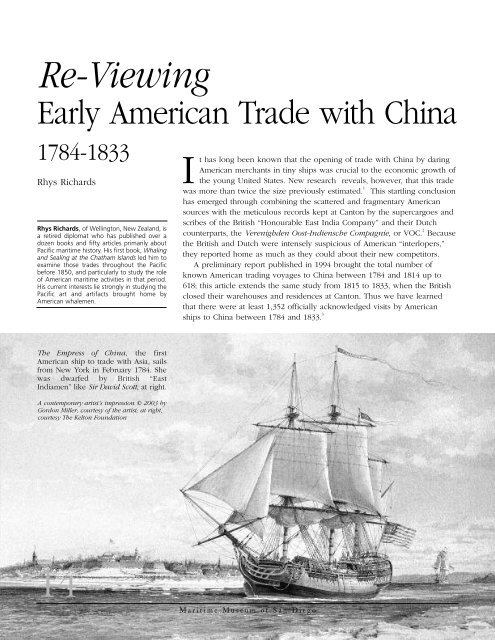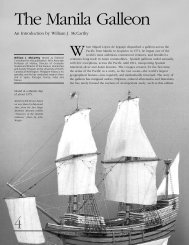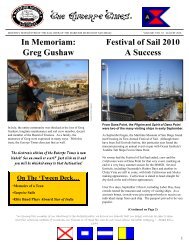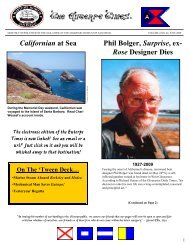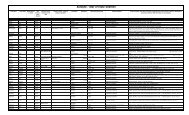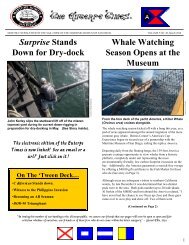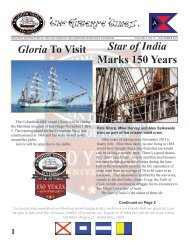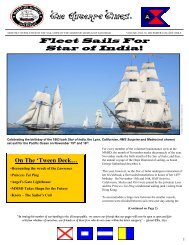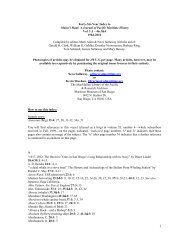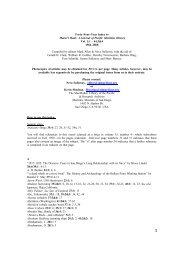Early American Trade with China - Maritime Museum of San Diego
Early American Trade with China - Maritime Museum of San Diego
Early American Trade with China - Maritime Museum of San Diego
Create successful ePaper yourself
Turn your PDF publications into a flip-book with our unique Google optimized e-Paper software.
Re-Viewing<br />
<strong>Early</strong> <strong>American</strong> <strong>Trade</strong> <strong>with</strong> <strong>China</strong><br />
1784-1833<br />
Rhys Richards<br />
Rhys Richards, <strong>of</strong> Wellington, New Zealand, is<br />
a retired diplomat who has published over a<br />
dozen books and fifty articles primarily about<br />
Pacific maritime history. His first book, Whaling<br />
and Sealing at the Chatham Islands led him to<br />
examine those trades throughout the Pacific<br />
before 1850, and particularly to study the role<br />
<strong>of</strong> <strong>American</strong> maritime activities in that period.<br />
His current interests lie strongly in studying the<br />
Pacific art and artifacts brought home by<br />
<strong>American</strong> whalemen.<br />
It has long been known that the opening <strong>of</strong> trade <strong>with</strong> <strong>China</strong> by daring<br />
<strong>American</strong> merchants in tiny ships was crucial to the economic growth <strong>of</strong><br />
the young United States. New research reveals, however, that this trade<br />
was more than twice the size previously estimated. 1<br />
This startling conclusion<br />
has emerged through combining the scattered and fragmentary <strong>American</strong><br />
sources <strong>with</strong> the meticulous records kept at Canton by the supercargoes and<br />
scribes <strong>of</strong> the British “Honourable East India Company” and their Dutch<br />
counterparts, the Verenighden Oost-Indiensche Compagnie, or VOC. 2 Because<br />
the British and Dutch were intensely suspicious <strong>of</strong> <strong>American</strong> “interlopers,”<br />
they reported home as much as they could about their new competitors.<br />
A preliminary report published in 1994 brought the total number <strong>of</strong><br />
known <strong>American</strong> trading voyages to <strong>China</strong> between 1784 and 1814 up to<br />
618; this article extends the same study from 1815 to 1833, when the British<br />
closed their warehouses and residences at Canton. Thus we have learned<br />
that there were at least 1,352 <strong>of</strong>ficially acknowledged visits by <strong>American</strong><br />
ships to <strong>China</strong> between 1784 and 1833. 3<br />
The Empress <strong>of</strong> <strong>China</strong>, the first<br />
<strong>American</strong> ship to trade <strong>with</strong> Asia, sails<br />
from New York in February 1784. She<br />
was dwarfed by British “East<br />
Indiamen” like Sir David Scott, at right.<br />
A contemporary artist’s impression © 2003 by<br />
Gordon Miller; courtesy <strong>of</strong> the artist; at right,<br />
courtesy The Kelton Foundation<br />
14<br />
M a r i t i m e M u s e u m o f S a n D i e g o
The early <strong>American</strong> <strong>China</strong> trade had three main<br />
branches: voyages made to <strong>China</strong> directly from<br />
the United States; fur trading voyages made by<br />
way <strong>of</strong> the northwest coast <strong>of</strong> America; and voyages<br />
made in the Pacific Ocean for furs, seal skins, aromatic<br />
sandalwood, bêche-de-mer (dried sea cucumbers—a<br />
Chinese delicacy), and other Pacific products that could<br />
be sold at and around Canton.<br />
This trade’s growth in its first two decades, from 1784<br />
to 1804, was extraordinary. The first <strong>American</strong> merchant<br />
ship arrived alone in 1784, and none followed in 1785,<br />
yet <strong>with</strong>in a decade <strong>American</strong> vessels were soon <strong>of</strong>ten as<br />
numerous as the English Company’s ships or their intraregional<br />
“Country” traders from India and the East. In<br />
one year, 1803, <strong>American</strong> vessels outnumbered those <strong>of</strong><br />
the British and all other nations combined, and over the<br />
first two decades they averaged over twenty percent <strong>of</strong><br />
the total number <strong>of</strong> ships visiting <strong>China</strong>.<br />
Almost all the <strong>American</strong> vessels, however, were quite<br />
small; most were about one quarter the size <strong>of</strong> the<br />
stately East Indiamen sent from Europe. In 1802 and<br />
1803 some fifty-nine U.S. vessels averaged just under<br />
three hundred tons apiece, while those <strong>of</strong> the British<br />
each averaged almost 1,200 tons. In July 1787, after<br />
cruising alone halfway round the globe, the crewmen <strong>of</strong><br />
one <strong>of</strong> the first <strong>American</strong> ships to arrive, the little 120-<br />
ton Columbia, were much amused when haughty<br />
Company <strong>of</strong>ficials mistook them for a mere tender to<br />
some larger vessel like their own.<br />
The outstanding feature <strong>of</strong> the <strong>American</strong>s’ trade at<br />
Canton was that they bought three times as much as<br />
they brought. This persistent deficit between imports and<br />
exports required that generally two-thirds <strong>of</strong> <strong>American</strong><br />
purchases had to be paid for <strong>with</strong> silver coin—an<br />
especially scarce commodity in the infant U.S.<br />
15<br />
“ F o r A l l t h e T e a i n C h i n a ” : A m e r i c a , A u s t r a l i a , a n d T h e C h i n a T r a d e
Sea otter pelts were the prize sought<br />
in 1787 by the first <strong>American</strong> vessels in<br />
the Pacific Northwest, the little<br />
Columbia and Lady Washington. The<br />
discovery <strong>of</strong> the Columbia River by the<br />
former was an accidental by-product<br />
<strong>of</strong> the <strong>China</strong> trade.<br />
A contemporary artist’s impression, © 2003 by<br />
Gordon Miller; courtesy <strong>of</strong> the artist<br />
Consequently, in order to obtain teas, silks and other wares for <strong>American</strong><br />
and European markets, <strong>American</strong> traders put every effort into finding<br />
alternatives. When they could, they sold New England goods en route,<br />
purchasing raw cotton, for example, at the Île de France (now Mauritius) or<br />
in India, which when sold at Canton sometimes paid for as much as a third<br />
<strong>of</strong> their own purchases. But here too the small size <strong>of</strong> the <strong>American</strong> vessels<br />
told against them, and between 1784 and 1804 U.S. vessels accounted for<br />
only three percent <strong>of</strong> the raw cotton that foreigners delivered to Canton.<br />
The canny <strong>American</strong>s therefore sought out specialty or novelty trades to<br />
provide whatever the Chinese would buy. Ginseng roots, which grew wild in<br />
the Hudson Valley, were usually worth almost their weight in silver to the<br />
Chinese, who prized their medicinal properties. Their price, however, proved<br />
unreliable. Lead from home was another significant item, but a wide range <strong>of</strong><br />
odd products were collected en route. A list <strong>of</strong> items sold to the Chinese in<br />
1799 included sandalwood, camphor, furs, mother <strong>of</strong> pearl, elephant teeth,<br />
dragon’s blood (a resinous substance used to make varnishes), mother <strong>of</strong><br />
pearl, mocha stones (moss agates), delicacies including cloves, nutmegs,<br />
birds’ nests, fishmaws, shark fins, bêche de mer, and products coveted for<br />
their real or imagined medicinal properties, such as cow bezoars—<br />
concretions from bovine stomachs supposed to neutralize poisons—ginseng,<br />
and rhinoceros horn. 4 <strong>American</strong>s did little trade in opium until after the price<br />
per chest soared from $580 in 1802 to $1,350 in 1804.<br />
16<br />
M a r i t i m e M u s e u m o f S a n D i e g o
The <strong>American</strong>s developed the previously modest fur trade, and soon<br />
dominated it. An enormous growth in the fur trade is apparent in<br />
British Company records, even though many <strong>American</strong> captains<br />
preferred to smuggle their furs through the back doors <strong>of</strong> the Celestial<br />
Kingdom. In 1792 the English sold 77,330 “fine furs” such as sea and river<br />
otter, beaver, fox, marten, and fur seal, while the <strong>American</strong>s sold only 7,579,<br />
or one tenth as many. These roles soon reversed. From 1800 to 1804, the<br />
English annually sold an average <strong>of</strong> 26,776 fine furs, while the <strong>American</strong>s’<br />
annual average was no less than 324,264 sold. Of the latter total, ninety<br />
percent were fur seal skins, worth altogether about a quarter <strong>of</strong> a million<br />
dollars each year. Sea otter pelts, though far fewer in number, were much<br />
more valuable, and the 42,527 sold by <strong>American</strong>s <strong>of</strong>ficially in Canton in 1802<br />
probably fetched close to a million dollars. Moreover, almost all <strong>of</strong> that was<br />
pr<strong>of</strong>it, since the expenses incurred in sealing or in trading on the Northwest<br />
Coast were very small indeed.<br />
<strong>American</strong> purchases were much less varied, <strong>with</strong> black teas generally well<br />
over half the total in value. In 1792, for example, teas accounted for half the<br />
total <strong>American</strong> cargoes by value, wrought silks for twenty percent, and<br />
quicksilver (mercury) for fifteen percent. Comparatively small shipments <strong>of</strong><br />
raw silk, sugar, durable “nankeen” cloth, porcelain, lacquered goods and<br />
other “<strong>China</strong> wares” made up the remainder. But here again the small size <strong>of</strong><br />
the <strong>American</strong> vessels is evident, for although over these two decades<br />
<strong>American</strong> vessels numbered twenty percent <strong>of</strong> the total, they carried on<br />
average only ten percent <strong>of</strong> the tea exported, and under four percent <strong>of</strong> the<br />
silk.<br />
Initially, the long-established European merchants were amazed that the<br />
<strong>American</strong> cockleshell adventurers could survive and prosper in such<br />
competitive, speculative trades. Ultimately, however, it was the restrictive<br />
chartered monopolies like the British and Dutch East India Companies that<br />
could not survive against the freer competition <strong>of</strong> the small, individuallyowned<br />
vessels <strong>of</strong> the <strong>American</strong>s.<br />
Sea otter fur was worn by high<br />
mandarins in coat linings or collars,<br />
esteemed for its lushness—otters have<br />
about 650,000 hairs per square inch,<br />
while the entire scalp <strong>of</strong> an average<br />
human has only 100,000. Yankees,<br />
Britons, Russians, Aleuts, and even<br />
California Indians hunted them. Pelts<br />
fetched $30 apiece on Canton’s streets<br />
in 1830, where the fur seller below was<br />
painted around 1805. Only opium,<br />
smoked by addicts in “dens” like the<br />
one engraved in 1843 at left, proved<br />
more lucrative.<br />
Above, John James Audobon, below, © 2003<br />
The Kelton Foundation<br />
“ F o r A l l t h e T e a i n C h i n a ” : A m e r i c a , A u s t r a l i a , a n d T h e C h i n a T r a d e<br />
17
The standard currency was the Spanish<br />
8-real “piece <strong>of</strong> eight,” stamped by<br />
Chinese <strong>of</strong>ficials <strong>with</strong> “chop marks”<br />
certifying correct purity and weight.<br />
Silver reached <strong>China</strong> aboard ships like<br />
the Vancouver <strong>of</strong> New York, at right,<br />
flying the house flag <strong>of</strong> David Ogden’s<br />
Red Cross Line. The Chinese artist who<br />
painted her in Chinese waters around<br />
1850 was probably commissioned by<br />
her captain or owner.<br />
Coin courtesy Edward von der Porten,<br />
photographed by John Wright; painting<br />
© 2003 The Kelton Foundation<br />
18<br />
In the third decade <strong>of</strong> <strong>American</strong> trade <strong>with</strong><br />
<strong>China</strong>, from 1805 to 1814, 308 <strong>American</strong><br />
vessels visited—almost double the number<br />
previously estimated by other scholars. The<br />
new total is probably still incomplete as this<br />
was a period <strong>of</strong> substantial <strong>American</strong><br />
smuggling through Macao, or the bays<br />
nearby, in order to avoid the heavy taxes<br />
and “squeeze” exacted by Chinese<br />
authorities at Whampoa and Canton. During<br />
the War <strong>of</strong> 1812, the British Navy blockaded<br />
Whampoa, Canton’s anchorage, and though<br />
a few brave or foolish captains escaped,<br />
most <strong>of</strong> the U.S. vessels that reached<br />
Whampoa stayed there till the war was over.<br />
The interuptions <strong>of</strong> the War <strong>of</strong> 1812<br />
and the Napoleonic Wars in Europe<br />
altered the <strong>China</strong> trade significantly.<br />
After the Peace <strong>of</strong> 1815, <strong>American</strong> reliance upon opportunistic cargoes<br />
gathered en route declined as trade developed in more enduring<br />
commodities and, later, in opium.<br />
Meanwhile the <strong>American</strong> home market had grown, <strong>with</strong> more capital and<br />
more silver specie, so that the trade shifted away from individual investors<br />
and small partnerships to concentrate in the hands <strong>of</strong> a few large companies<br />
in larger ports like New York, Boston, Salem and Philadelphia. The trade<br />
grew to average $6.3 million each year, but under forty percent was paid for<br />
by commodities, while bills <strong>of</strong> exchange and Spanish silver dollars accounted<br />
for over sixty percent <strong>of</strong> all <strong>American</strong> purchases. <strong>American</strong> trade <strong>with</strong> <strong>China</strong><br />
after 1815 was marked by consolidation and growth, <strong>with</strong>out the feverish<br />
expansion <strong>of</strong> preceding decades.<br />
This <strong>American</strong> trade <strong>with</strong> <strong>China</strong> was very much larger than previous<br />
sources have suggested. In the five years from 1816 to 1820, for example,<br />
there were at least 196 <strong>American</strong> visits—or almost four times as many as the<br />
fifty-four known previously. An average <strong>of</strong> thirty-seven <strong>American</strong> merchant<br />
vessels called at Canton annually from 1815 to 1833.<br />
Besides setting the record straight about the true scale <strong>of</strong> <strong>American</strong> trade<br />
<strong>with</strong> <strong>China</strong>, recent research lays to rest old rivalries over which ports sent the<br />
most vessels to <strong>China</strong>. Among the 1,077<br />
declared homeports <strong>of</strong> <strong>American</strong> ships<br />
trading <strong>with</strong> <strong>China</strong> between 1784 and<br />
1832, Boston and Salem accounted for one<br />
third <strong>of</strong> all <strong>American</strong> visits; Philadelphia<br />
and Baltimore together were over a<br />
quarter, while New York and “Rhode<br />
Island” made up twenty-four and twelve<br />
percent respectively. 5 Of the other voyages<br />
from minor ports, eleven were from New<br />
Haven, while, rather surprisingly, nine<br />
hailed from New Bedford and six from<br />
Nantucket.<br />
M a r i t i m e M u s e u m o f S a n D i e g o
From these painstakingly assembled vessel-by-vessel<br />
lists, it can be seen more clearly that the early <strong>China</strong><br />
trade was not a mere passing phase, but played an<br />
important role as the young United States developed its<br />
new export trades on a scale that was substantial, and<br />
truly global.<br />
N O T E S<br />
1 The earliest significant assessment <strong>of</strong> the scale <strong>of</strong> trade was by<br />
Kenneth Scott Latourette, who in 1917 and 1927 listed 294<br />
1784-1804 U.S. voyages to <strong>China</strong>. In 1926, Hosea Ballou Morse<br />
published summaries <strong>of</strong> British trade and included the number<br />
<strong>of</strong> U.S. vessels at Canton annually, but <strong>with</strong>out details. In 1994<br />
The <strong>American</strong> Neptune published a special supplement by this<br />
author listing, voyage-by-voyage, 618 vessels and citing data<br />
from U.S., British and Dutch sources. Latourette, “The History <strong>of</strong><br />
<strong>Early</strong> Relations Between the United States and <strong>China</strong>.”<br />
Transactions <strong>of</strong> the Connecticut Academy <strong>of</strong> Arts and Sciences<br />
22 (1917): 1-209; Latourette, “Voyages <strong>of</strong> <strong>American</strong> Ships to<br />
<strong>China</strong>, 1784-1844.” Ibid., 28 (1927): 237-71; Morse, The<br />
Chronicles <strong>of</strong> the East India Company Trading to <strong>China</strong> 1635-<br />
1834 (Oxford: Clarendon Press, 1926); Rhys Richards, “United<br />
States <strong>Trade</strong> With <strong>China</strong> 1784-1814,” The <strong>American</strong> Neptune 54<br />
(1994), Special Supplement.<br />
2 Primary sources for this article include a table summarizing<br />
trade commodities and totals, 1804-1821, box 244, Carrington<br />
Papers, Rhode Island Historical Society Library, Providence, and<br />
a ledger at Mystic Seaport listing vessels and their captains, <strong>with</strong><br />
extensive detail on cargoes, for the seasons 1819-20 to 1832-<br />
1833. (Untitled Ledger, George W. Lyman Invoices and <strong>Trade</strong><br />
Papers 1812 to 1821, M.L. HFM 176, G. W. Blunt White Library,<br />
Mystic Seaport, Mystic, Connecticut.) The remaining 1816-1819<br />
gap was filled by analysis <strong>of</strong> “Records <strong>of</strong> the Directors and the<br />
Select Committee <strong>of</strong> Supercargoes <strong>of</strong> the Honourable East<br />
India Company,” East India Office, British <strong>Museum</strong>, CFR<br />
Canton Diaries and Consultations, series G/12 (cited<br />
hereinafter as “EIC Records”), vols. 204 to 257. These revealed<br />
names and captains for almost all U.S. vessels trading legally<br />
at Canton except the 1816-17 season. Data for 1816-17 was<br />
found in records <strong>of</strong> the Dutch Committee at Canton, VOC<br />
1.04.20. 1742-1826, at the Dutch National Archives, The<br />
Hague. They also frequently provide details not recorded by<br />
the English.<br />
3 The figure is probably still incomplete given the prevalence <strong>of</strong><br />
smuggling. Because this overview is based upon statistics<br />
compiled from sources too numerous to cite here, please see<br />
the bibliography for the 1784-1815 period in Richards, “United<br />
States <strong>Trade</strong>.” Apart from the sources mentioned therein, five<br />
additions are required. To the manuscript list may be added<br />
the aforementioned ledger at Mystic, and the 1804-1821 table<br />
and “Reminiscences <strong>of</strong> William C. Townsend” at the Rhode<br />
Island Historical Society. To published works may be added<br />
James Hunnewell, “Hawaii in the 1820s,” Papers <strong>of</strong> the<br />
Hawaiian Historical Society, 1895, pp. 6-16; Mary Malloy,<br />
“Boston Men” on the Northwest Coast: The <strong>American</strong> <strong>Maritime</strong><br />
Fur <strong>Trade</strong> 1788-1844 (Fairbanks, AK: Limestone Press, 1998);<br />
<strong>San</strong>dra Wagner-Wright, ed., Ships, Furs and <strong>San</strong>dalwood: A<br />
Yankee <strong>Trade</strong>r in Hawaii 1823-1825: Charles H. Hammatt<br />
(Honolulu: University <strong>of</strong> Hawaii Press, 1999). Copies <strong>of</strong> the<br />
work on which this article is based, “United States <strong>Trade</strong> <strong>with</strong><br />
<strong>China</strong>: List <strong>of</strong> U.S. Vessels at <strong>China</strong>: An Extension from 1815 to<br />
1820,” are at the Phillips Library at the Peabody Essex<br />
<strong>Museum</strong>, Salem, in the G. W. Blunt White Library, and at the<br />
Rhode Island Historical Society.<br />
4 EIC Records, book 127.<br />
5 Between 1784 and 1832, Boston- and Salem-based ships<br />
accounted for 306 and 56 <strong>China</strong> visits respectively; at times,<br />
however, these ports seem to have been listed almost<br />
interchangeably. 260 others came from Philadelphia, 254 from<br />
New York, 124 from Rhode Island, and 32 from Baltimore.<br />
Data is unavailable for 1821 and 1826.<br />
“ F o r A l l t h e T e a i n C h i n a ” : A m e r i c a , A u s t r a l i a , a n d T h e C h i n a T r a d e<br />
19


